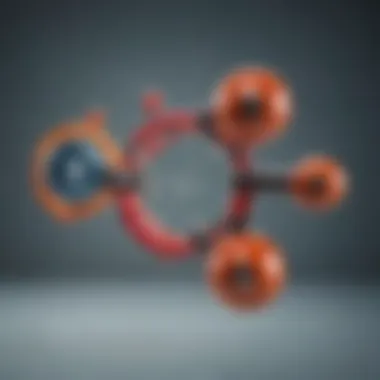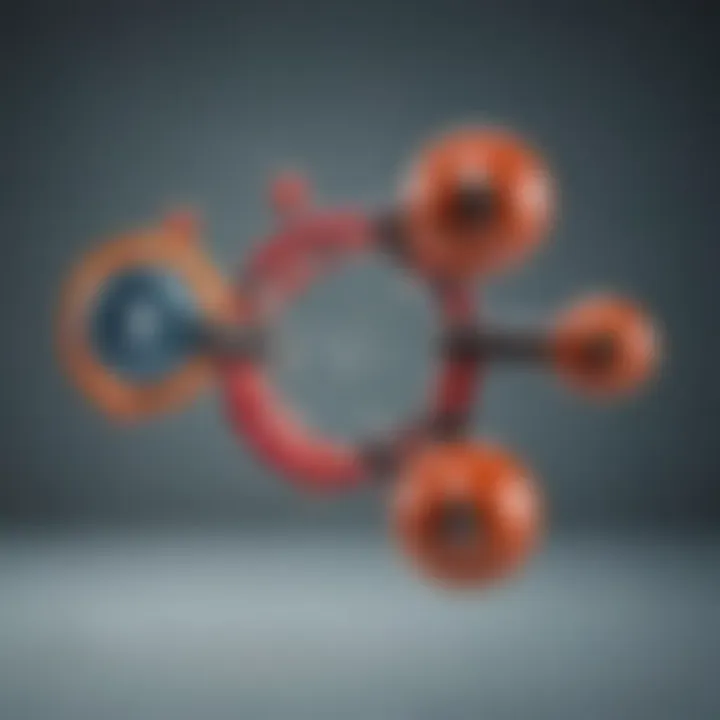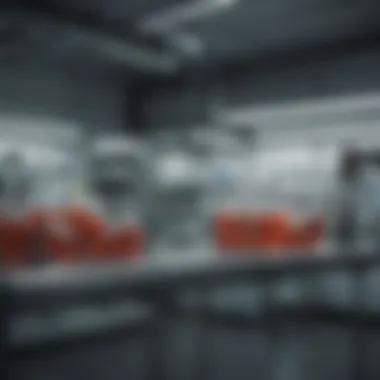Strontium Chloride: Properties, Applications, and Impact


Intro
In the realm of chemistry, strontium chloride stands out as more than just a ubiquitous compound; it is a linchpin across various industries, from healthcare to materials science. This substance, made up of strontium and chlorine, dazzles with its high solubility in water, contributing significantly to its application in different fields. Not only does it act as a valuable reagent, but it also has a striking role in the creation of strontium-based products used in everyday life.
Exploring strontium chloride opens a door to understanding its synthesis, characteristics, and multiple applications. This overview aims to delve into these aspects while also shedding light on both environmental implications and potential health risks associated with its use. By parsing through these key points, the narrative will provide a well-rounded perspective on strontium chloride and its relevance in today’s scientific landscape.
Prologue to Strontium Chloride
Strontium chloride is more than just a simple salt; it’s a compound that has carved out its own niche in both medical and industrial landscapes. Understanding what strontium chloride is, holds significance not only for professionals in the chemistry domain but also for researchers and health specialists who might be exploring its applications.
It stands ambivalent between science and practical utility, offering opportunities for innovation and solution-based approaches in various fields. The focus of this article will not only explore the intricacies of its chemical properties and synthesis methods but also delve into the wide range of its applications, particularly emphasizing its importance in medical and industrial contexts.
What is Strontium Chloride?
Strontium chloride, having the chemical formula SrCl₂, is a salt formed from strontium and chloride ions. This white crystalline compound is highly soluble in water, making it an interesting subject for various applications. Strontium itself is an alkaline earth metal, similar to calcium. What's fascinating about strontium chloride is not just its structure but also its versatility. Even though it is often overshadowed by more well-known salts, its utility in areas like medical imaging and materials science is worth taking note of.
In the lab, this compound can be utilized in chemical reactions, while its chloride form helps in a variety of settings, from fireworks to certain glass manufacturing processes, showing just how far-reaching its impacts can be.
Historical Context
The history of strontium compounds goes back to the late 18th century, with strontium itself being discovered in 1790 by a chemist named Adair Crawford. The compound started gaining attention well into the 19th century when it was recognized for its fluorescent properties when burned. Strontium chloride specifically began making rounds in scientific circles as researchers explored its crystalline structure and solubility characteristics.
In medical contexts, it became notable during the mid-20th century for its potential role in bone health, particularly amidst increasing research into osteoporosis and related conditions. Historical records suggest that strontium compounds showed promise, boosting the interest in strontium chloride for potential therapeutic uses. As time progressed, its applications diversified, solidifying its place in both academic research and practical applications.
Strontium chloride’s journey from an obscure compound to a relevant player in both science and industry is not just a tale of discovery, but a testament to its varied functionalities and the constant evolution of scientific understanding.
Chemical Properties
Understanding the chemical properties of strontium chloride is crucial, as these properties dictate its applications, behavior in various settings, and how it interacts with other substances. It’s the kind of information that influences everything from industrial processes to health considerations. The emphasis on chemical properties in this article serves to inform readers about the distinct characteristics that make strontium chloride a noteworthy compound.
Molecular Structure
Strontium chloride, chemically denoted as SrCl₂, consists of strontium cations ( Sr²⁺) and chloride anions (Cl⁻). This ionic compound forms a crystalline structure that is quite stable and exhibits unique attributes. Each strontium ion is surrounded by six chloride ions, arranging themselves in a geometrical pattern which maximizes stability and minimizes potential energy.
In simpler terms, picture a circle where the strontium ion is at the center, radiating outward with chloride ions anchored at the perimeter. This structured design is not just for show; it directly influences the physical properties of the compound such as its melting point, boiling point, and solubility. The stronger the ionic bonds in the structure, the more resilience the compound tends to have against changes in temperature and pressure.
Solubility Characteristics
The solubility of strontium chloride in water is a significant aspect to ponder. It easily dissolves, yielding a clear and colorless solution. This solubility is attributed to the strong interaction between the polar water molecules and the strontium and chloride ions, which allows the ionic lattice to break down.
In practice, this means that in a laboratory or industrial context, strontium chloride can be utilized in solutions quite effortlessly. Here’s a simple point to digest:
- It’s highly soluble in water, making it convenient for chemical applications.
- Forms a saturated solution relatively quickly, releasing essential ions into the solution.
However, a word of caution—its solubility can be influenced by temperature and ionic strength in the solution. High salt concentrations or increases in temperature can lead to variations in solubility, which might be necessary to consider in practical applications.
Thermal Properties
Thermal properties of strontium chloride play a key role especially in processes that involve temperature fluctuations. The compound has a melting point in the ballpark of 649 degrees Celsius, and it doesn’t decompose until it reaches much higher temperatures. This provides an adequate range for various applications that require heating.
When heated, strontium chloride doesn’t break down immediately, which is desirable in manufacturing processes that involve thermal treatments. Here are some points worth noting:
- It retains structural integrity at moderate to high temperatures.
- Exhibits a high thermal stability which is advantageous for applications in glass and ceramics production.


"The ability of strontium chloride to withstand temperature variations makes it a fitting candidate for use in industries that rely on high-heat processes."
Synthesis and Production
The synthesis and production of strontium chloride are fundamental topics in understanding the full scope of its applications and significance. This section highlights the various methods to synthesize strontium chloride, providing insight into both pharmaceutical and industrial contexts. Knowing how strontium chloride is produced not only informs readers about its availability but also reveals the nuances of purity, cost-efficiency, and potential environmental impacts.
Methods of Synthesis
Neutralization Reactions
Neutralization reactions stand out as a critical method for the synthesis of strontium chloride. Essentially, this process involves the reaction between a strong acid, commonly hydrochloric acid, and a strong base such as strontium hydroxide. The key characteristic of this process is its simplicity. With readily available reagents, the methods yield a high-purity product while maintaining relatively low operating costs.
A beneficial aspect of neutralization reactions is their efficiency in producing strontium chloride in liquid form, which can then be easily converted to solid form via evaporation or crystallization. However, the chemical handling involved calls for stringent safety measures to mitigate risk, as concentrated hydrochloric acid poses hazards. The environmentally impact of neutralization can also be considered, as proper waste management is paramount to avoid releasing harmful byproducts into ecosystems.
Unique features of neutralization reactions also include producing a largely homogenous solution, allowing for an easier purification process post-reaction. This method may be contrasted to others that can yield impure products requiring extensive further processing, which adds to the timeline and costs associated with production.
Ion Exchange Techniques
Ion exchange techniques serve as another viable method for synthesizing strontium chloride, particularly when higher purity is desired. In this case, strontium ions are exchanged for other cationic species in a resin bed. This method is particularly notable for its capability to selectively isolate strontium from a mixture of ions present in a solution.
A significant characteristic of ion exchange is its adaptability to various feed compositions, making it an excellent choice for scenarios where strontium is derived from complex matrices such as natural mineral sources. The efficiency of this technique in removing unwanted ionic contaminants elevates its appeal in specialized applications like radiopharmaceuticals.
Nonetheless, one should be cognizant of its disadvantages, primarily the cost of resin and the time required to achieve desired ion loadings. Furthermore, the sustainability of resin use can impact the overall ecological footprint depending on resin life cycles and disposal processes.
Industrial Production Techniques
In industrial settings, strontium chloride is typically produced through more large-scale processes. Techniques used may include neutralization reactions as previously discussed but can also encompass additional steps like recrystallization on an industrial scale to ensure high yield and purity.
- Batch Processing: This method involves mixing specific quantities of reactants to produce desired outputs. Although simple, it often necessitates extensive monitoring to control reaction conditions and thus ensure quality.
- Continuous Processing: An advanced method that allows for sustained production with constant input of raw materials. This leads to economies of scale but requires robust control systems to monitor reactor conditions continuously.
Maintaining regulatory compliance in production is crucial, considering the chemical's wide-ranging applications, particularly in healthcare and environmental monitoring. Ensuring that manufacturing processes do not generate hazardous byproducts is a priority for many organizations involved in strontium chloride production.
Strontium chloride, given its importance across sectors, is synthesized through varied and innovative methodologies, each with its own set of considerations, advantages, and potential drawbacks.
Applications of Strontium Chloride
Strontium chloride finds itself at the intersection of various sectors, thanks in large part to its unique properties. In this section, we will delve into how this compound is used in both medical and industrial fields, as well as its role in environmental monitoring. The diverse applications illustrate its significance, shedding light on why understanding this compound is essential for students, researchers, and industry professionals alike.
In the Medical Field
Strontium in Bone Health
One of the standout applications of strontium chloride is its role in promoting bone health. Strontium has been studied for its potential to enhance bone density, making it an increasingly popular option among osteoporosis treatments. The key characteristic here is its ability to mimic calcium, which offers a unique approach to stimulating bone formation.
A major advantage of using strontium in bone therapy is its dual action: it not only aids in building up the bone mass but also reduces bone resorption, which is the process of breaking down bone. This makes it a beneficial compound in addressing conditions like osteoporosis, where bone strength is compromised. Moreover, clinical studies have indicated that strontium ranelate, a compound derived from strontium, could significantly lower fracture rates in postmenopausal women.
However, there are considerations to keep in mind. While strontium can assist in bone health, it may pose certain risks if used excessively. This balance makes it crucial for healthcare professionals to evaluate patient history and any potential contraindications carefully.
Radiopharmaceuticals
Another critical application of strontium chloride is in the field of radiopharmaceuticals. Strontium-89, a radioactive isotope, is often used for pain relief, especially in the case of metastatic bone cancer. Its key characteristic lies in its ability to localize in areas of high bone turnover, which is prevalent in cancer lesions, thereby allowing for targeted therapy.
The unique feature of strontium-89 is its external beam radiation property, providing an effective means to alleviate pain without heavy systemic side effects common to other forms of treatment. This is why many medical professionals consider it a popular choice in palliative care. Yet, potential disadvantages exist; the handling and disposal of radioactive materials require stringent regulatory compliance, which can be a logistical hurdle in many healthcare settings.
In Industrial Use


Manufacturing of Ceramics
In the ceramics industry, strontium chloride plays a pivotal role in manufacturing various products, ranging from tiles to sanitary ware. Its main contribution here is as a flux, which helps lower melting points, thereby facilitating the production process.
The key characteristic of strontium chloride in ceramics is its ability to influence the physical properties of the final product. For example, it can enhance the durability and strength of ceramics. This aspect makes it a beneficial addition that companies rely on to yield high-quality goods. However, it’s beneficial to be mindful of costs, as the use of strontium salts can sometimes elevate production expenses compared to more commonplace materials.
Glass Applications
When it comes to glass manufacturing, strontium chloride can make a remarkable impact. It is often utilized in producing optically clear glass and special glasses used in various applications, including optics and laboratory equipment. The significant feature of strontium in glass is its role in controlling the refractive index, which is crucial for applications demanding high precision.
Strontium's ability to produce clarity and strength in glasswork is what makes its use advantageous. However, manufacturers must be wary of its source and the environmental impact of strontium extraction and disposal. Balancing performance with sustainability becomes a responsibility for industries engaged in this chemical’s applications.
Environmental Monitoring
The utility of strontium chloride also extends into environmental monitoring. As a compound, it serves as a marker for monitoring strontium levels in various ecosystems, particularly since strontium can substitute for calcium in biological systems. This substitution has implications in studies surrounding biodiversity and the health of aquatic environments.
? Understanding strontium levels in the environment can help gauge ecological health, especially in water sources where agriculture and industrial activities are prevalent.
In summary, the multifaceted applications of strontium chloride underscore its wide-ranging impact across sectors. From medical advancements that improve bone health to applications in ceramics and glass manufacturing, the significance of this compound cannot be understated. Additionally, as the demand for environmental assessments continues to rise, strontium chloride remains a relevant player in ecological studies.
Health Implications
Understanding the health implications related to strontium chloride is crucial, particularly given its varied applications across different fields. While its potential benefits in medicine and industry are clear, it also comes with certain risks. This aspect of the article examines vital points regarding toxicity, exposure, and regulatory guidelines that shape the use of this compound in practical scenarios.
Toxicity and Safety
Strontium chloride is not without its toxicological concerns. Although it is considered less toxic than other heavy metals, its safety profile cannot be overlooked. Some studies indicate that excessive exposure might lead to neurological issues or inflammatory responses. Generally, strontium compounds can interfere with calcium metabolism, which is a critical aspect of bone health. This is a double-edged sword since, while strontium can positively impact bone density, an imbalance could lead to serious health complications.
Important Note: Always follow safety guidelines when handling strontium chloride to minimize any potential health risks.
Handling strontium chloride requires appropriate precautions:
- Use Personal Protective Equipment: Gloves and safety goggles are essential in preventing skin and eye contact.
- Ventilation is Key: Ensure that the working environment is well-ventilated to mitigate inhalation risks.
- Proper Disposal: Follow local regulations for the disposal of chemical waste to avoid environmental contamination.
Exposure Risks
Exposure risks associated with strontium chloride can appear from multiple channels, including occupational settings, environmental exposure, and even through dietary sources. For individuals working in laboratories or production facilities, skin contact or inhalation poses significant risks, particularly during the waste disposal processes or synthesis operations.
It's interesting to note that certain foods can also contain trace amounts of strontium. This might not be alarming in low concentrations, but for those individuals whose diets are severely strontium-laden, the risk of exposure could climb. Some potential health effects of prolonged exposure include:
- Bone Alterations: High levels might alter bone turnover rates.
- Gastrointestinal Issues: Ingestion can sometimes lead to nausea or diarrhea, although these instances are rare.
Regulatory Guidelines
Regulatory bodies have established guidelines to ensure the safe handling and usage of strontium chloride, particularly in professional settings. In the United States, the Environmental Protection Agency (EPA) and the Occupational Safety and Health Administration (OSHA) oversee the management of strontium chloride hazards. These guidelines cover various aspects, such as:
- Exposure Limits: OSHA sets permissible limits for occupational exposure, ensuring that workers are not subjected to levels deemed unsafe over specified durations.
- Labeling and Safety Data Sheets: Strontium chloride must be adequately labeled in any commercial product, and Material Safety Data Sheets (MSDS) should be readily accessible to provide clear information on risks and safety measures.
In different countries, regulations may vary. Therefore, it is crucial to be informed about local safety requirements and adhere to them in all operational practices. Government agencies ensure that manufacturers provide necessary safety guidelines, keeping health risks at bay.
In summary, while strontium chloride serves useful purposes in medical and industrial realms, awareness of its health implications is vital. Understanding toxicity, exposure risks, and following regulatory guidelines can significantly mitigate health hazards.
Environmental Impact
Understanding the environmental impact of strontium chloride is crucial for comprehensively discussing its multifaceted nature. This salt, while benefiting various industries, poses potential ecological concerns that merit attention. From its effects on ecosystems to compliance with regulations, these factors play a significant role in managing its use responsibly. In this section, we delve into the ecological effects and the regulatory measures that guide the use of strontium chloride in order to mitigate risks associated with environmental degradation.


Ecological Effects
The presence of strontium chloride in the environment can have several ecological ramifications. Its high solubility means it can easily be transported into waterways, potentially entering ecosystems and affecting aquatic life.
- Soil and Water Systems: When strontium chloride dissolves, it can alter the concentration of strontium ions in soil and sediment. This shift can have a knock-on effect on plant growth, with some studies suggesting that elevated strontium levels can hinder the absorption of essential nutrients.
- Aquatic Life: Strontium ions can mimic calcium in biological systems, which raises concerns for aquatic organisms. Fish and other marine life might absorb strontium, leading to bioaccumulation over time. This can disrupt their biological processes, effects that are not yet fully understood but raise alarms among ecologists.
- Trophic Levels: As strontium moves through the food chain, the elevation of its concentration may affect predators, potentially causing harmful impacts at various trophic levels. This cascading effect poses a risk of compromising biodiversity in ecosystems.
"The balance of nature is delicate, and the introduction of substances like strontium chloride can tip the scales in unforeseen ways."
Regulatory Compliance
Navigating the complexities of strontium chloride requires following stringent regulatory measures designed to minimize environmental risks. Different jurisdictions have laws focusing on chemical management, with strontium being no exception. The following points illustrate important aspects of regulatory compliance:
- Permitting: Industries that intend to utilize strontium chloride must often obtain permits that detail their intended usage and disposal methods. This ensures that manufacturers are held accountable for their practices.
- Monitoring: Regular environmental monitoring is mandated in many regions to track the levels of strontium in the environment, especially in areas where industrial activities are prevalent. This process helps assess whether concentrations remain within safe limits.
- Reporting Requirements: Many authorities require periodic reporting on the types and amounts of strontium chloride used or released into the environment. This data is critical for evaluating compliance with environmental standards.
- Remediation Measures: In instances where strontium chloride has been identified as a pollutant, regulatory agencies may mandate remediation action plans. Companies may be required to engage in cleanup processes to restore environments affected by excessive strontium levels.
These regulatory frameworks play an essential role in ensuring that while the advantages of strontium chloride are harnessed in various applications, its environmental footprint is managed thoughtfully.
Recent Research and Developments
Exploring the latest advancements in the field of strontium chloride is crucial for understanding its evolving role in science and industry. Recent research and developments show how this compound is not just static but dynamic, providing new opportunities and addressing current challenges. With industries pushing for sustainability and efficiency, ongoing studies focus on innovative synthesis methods and applications in medicine, reflecting a growing interest in enhancing the utility of strontium chloride.
Innovations in Synthesis
The advancement in synthesis techniques has taken the spotlight in the recent investigations surrounding strontium chloride. Traditional methods usually involve base neutralization or reacting strontium carbonate with hydrochloric acid. However, newer pathways explore more environmentally friendly and economically viable alternatives, especially using ion exchange techniques that offer higher purity yields.
Research indicates that one emerging technique, which uses refined salt solutions combined with advanced filtration systems, improves both efficiency and safety in the manufacturing process. This new approach not only saves resources but also minimizes waste. The implications of these innovations couldn't be more significant, especially in industrial applications where cost and environmental impact are constant concerns.
- Higher Purity: Improved synthesis techniques reduce contaminants, leading to a superior quality product.
- Cost-Effective: New methods lower production costs, making strontium chloride more accessible to various industries.
- Environmental Benefits: Reduced energy consumption and waste production align with global sustainability goals.
The importance of such innovations can't be overstated. These synthesis advancements could allow for broader implementation and integration of strontium chloride in numerous applications, ultimately leading to enhanced market competitiveness.
Research in Medicine
When it comes to medicine, strontium chloride is making waves. Its application in medical research has led to valuable insights, particularly concerning bone health and radiopharmaceuticals. Current studies explore how strontium, being chemically similar to calcium, may play a key role in stimulating bone growth and strength.
Research has shown that strontium-based compounds, including strontium chloride, can help in treating osteoporosis by promoting bone density and overall skeletal health. The compound has even been tested in clinical trials, confirming its effectiveness in improving patient outcomes. Noteworthy findings include:
- Bone Regeneration: Strontium chloride, combined with other treatments, may enhance the healing process in fractures and bone ailments.
- Mechanism of Action: Studies are focused on understanding how strontium interacts with osteoblasts and osteoclasts, paving the way for targeted therapies.
- Safety Profiles: Analyzing potential side effects ensures that strontium chloride can be safely integrated into treatment regimens.
Furthermore, in the realm of radiopharmaceuticals, strontium-89 has been under investigation for pain relief in patients with metastatic bone cancer. Utilizing strontium's properties makes it a vital candidate for developing effective and specific treatments.
"Strontium chloride's potential in medicine extends beyond bone health, showcasing a promising future for both synthesis innovations and therapeutic applications."
Thus, the continued focus on strontium chloride in research serves not only to underline its importance in current frameworks but also to open doors to future possibilities in both the industrial and medical fields.
The End
In concluding this article, it’s worth underscoring the pivotal role that strontium chloride plays across various fields. This compound is not merely a subject of academic interest; it has practical implications in medicine, industry, and environmental science. Understanding strontium chloride equips professionals and researchers with the insights needed to navigate its applications effectively and safely.
Summary of Key Points
To recap the salient features discussed in this article:
- Chemical Properties: Strontium chloride exhibits unique solubility characteristics that make it invaluable in both research and industrial applications. Its molecular structure allows for diverse uses ranging from pharmaceuticals to ceramics.
- Synthesis and Production: Various methods enable the production of strontium chloride, including neutralization reactions and ion exchange techniques, which highlight its versatility and adaptability in synthesis.
- Applications: The use of strontium chloride spans multiple domains such as medical applications focusing on bone health and its role in radiopharmaceuticals, as well as its significance in industrial manufacturing processes like ceramics and glass production.
- Health Implications: Awareness around toxicity and regulatory guidelines has been emphasized, showcasing the importance of safety when handling this compound.
- Environmental Impact: Discussions on ecological effects and compliance with regulations further illuminate the responsibilities associated with the use of strontium chloride.
- Recent Research: Innovations in synthesis and advancements in medical applications indicate the ongoing relevance and potential for future research.
Future Perspectives
Looking ahead, the future of strontium chloride appears promising. Continuing advancements in synthesis methods may lead to more efficient and environmentally friendly production processes. The medical field, particularly in areas dealing with bone health and related disorders, stands to benefit as new research emerges - potentially leading to the discovery of novel therapeutic approaches.
Moreover, as industries aim for sustainability, understanding the environmental impact of strontium chloride will become increasingly critical. There is a need for ongoing monitoring and adherence to regulatory frameworks to minimize ecological footprints.
In sum, strontium chloride is more than just a compound – it's a key player in a range of important sectors, and its future development will likely open new avenues for scientific exploration and industrial application.



